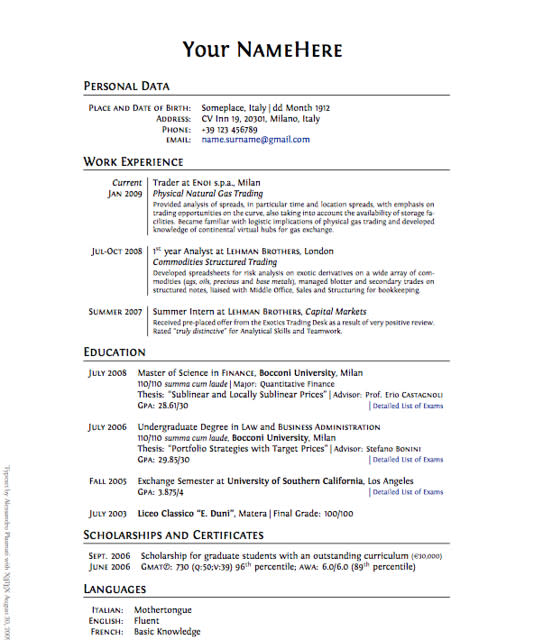The Dos And Don'ts Of Resume Formatting



When it comes to resume formatting, the way you present your information can make a big difference in catching the attention of potential employers. Did you know that recruiters spend an average of just six seconds scanning each resume? That's why it's crucial to follow the dos and don'ts of resume formatting to make sure your document stands out in that short window of opportunity.
One of the dos of resume formatting is to keep it clean and organized. Use clear headings, bullet points, and consistent formatting to guide the reader's eye and make the information easy to digest. On the flip side, one of the don'ts is overcrowding your resume with excessive details or using fancy fonts that could be difficult to read. Remember, simplicity is key when it comes to resume formatting.
Understanding Resume Formatting: The Dos and Don'ts
Creating a well-formatted resume is essential for catching the attention of potential employers and showcasing your skills and qualifications. The way you structure and format your resume can significantly impact whether you get called in for an interview or not. In this article, we will explore the dos and don'ts of resume formatting, providing you with valuable insights and practical tips to create a standout resume that grabs the attention of hiring managers.
One of the most important aspects of resume formatting is ensuring that your document is clear, professional, and easy to read. A well-organized resume not only showcases your experience and qualifications effectively but also demonstrates your attention to detail and organizational skills. Let's delve into the dos and don'ts of resume formatting to help you create a resume that stands out among the competition.
Before we dive into the specifics, it's important to note that different industries and professions may have their own preferred resume formats. It's crucial to research and understand the expectations of your target industry when formatting your resume. Now, let's explore the best practices and common mistakes to avoid when formatting your resume.
Dos of Resume Formatting
When formatting your resume, here are some key dos to keep in mind:
Use a clean and professional font, such as Arial or Calibri, with a font size between 10 and 12 points.
Ensure consistent formatting throughout your resume, including headings, bullet points, and indentation.
Use a reverse chronological order, starting with your most recent experience and working backward.
Include relevant section headings, such as "Professional Experience," "Education," and "Skills."
Focus on your accomplishments and quantify your results whenever possible.
Use bullet points to highlight key responsibilities and achievements in each job or experience.
Keep your resume concise and limit it to one or two pages, depending on your level of experience.
Choose a Clean and Professional Font
One of the first things to consider when it comes to resume formatting is the font you use. It's essential to choose a clean and professional font that is easy to read. Some recommended fonts for resumes include Arial, Calibri, and Times New Roman. These fonts are widely accepted in professional settings and can help give your resume a polished look.
Additionally, make sure to select an appropriate font size that is easily readable. The recommended font size for a resume is usually between 10 and 12 points. This ensures that your content is legible and doesn't strain the eyes of the reader.
Consistency is also key when it comes to font usage. Use the same font throughout your entire resume to maintain a cohesive and professional appearance. Using a consistent font style and size will make your resume look well-organized and easy to follow.
Follow a Reverse Chronological Order
When listing your work experience, it's generally recommended to use a reverse chronological order. Start with your most recent or current position and work your way backward. This format allows employers to see your most recent experiences and achievements first, which is often the most relevant information.
By following a reverse chronological order, you can highlight your career progression and demonstrate the growth and development of your skills over time. This format is particularly beneficial when you have relevant and recent experiences that align with the requirements of the job you're applying for.
However, if you're changing careers or have significant gaps in your work history, a different format, such as a functional or combination resume, may be more suitable. Tailor the resume format to your unique circumstances and the requirements of the role you're applying for.
Highlight Accomplishments and Use Bullet Points
When describing your work experience and achievements, it's crucial to focus on your accomplishments rather than simply listing job responsibilities. Highlight the impact you made in previous roles by quantifying your results and using action verbs.
Using bullet points can help you present your accomplishments and responsibilities in a clear and organized manner. Bullet points allow for easy readability and make it easier for hiring managers to skim through your resume and identify the most important aspects of your experience.
Remember to tailor your bullet points to demonstrate the specific skills and qualifications that are relevant to the position you're applying for. Use keywords from the job description to align your experience with the requirements of the role.
Don'ts of Resume Formatting
To ensure your resume stands out for the right reasons, here are some common resume formatting mistakes to avoid:
Avoid using excessive formatting, such as excessive bolding, italics, or underlining.
Don't clutter your resume with irrelevant information or non-essential details.
Avoid using complicated or decorative fonts that can be difficult to read.
Don't include personal information, such as your age, marital status, or social media profiles, unless relevant to the job.
Avoid using generic or cliché phrases that do not provide specific information about your skills and achievements.
Don't use excessive abbreviations or industry-specific jargon that may not be understood by all readers.
Avoid using long paragraphs; instead, use concise bullet points to convey information.
Don't include a photo, unless specifically required for the job application.
Avoid Excessive Formatting
While some formatting can enhance the appearance of your resume, it's essential to strike the right balance. Avoid excessive formatting, such as excessive bolding, italics, or underlining. These formatting elements can make your resume look cluttered and distract from the content.
Instead, use formatting sparingly to draw attention to key points or headings. For example, you might use bold font for section headings or to highlight important achievements. The goal is to ensure that your resume is visually appealing and easy to read without overwhelming the reader with excessive formatting.
Avoid Irrelevant Information
When crafting your resume, it's important to be selective about the information you include. Avoid cluttering your resume with irrelevant details that do not contribute to your qualifications for the job. Focus on including information that is directly related to and supports your application.
For instance, if you're applying for a marketing position, there's no need to include details about your high school part-time job at a fast-food restaurant unless it's directly relevant to the skills required for the marketing role. Tailor your resume to highlight the most valuable experiences and qualifications for the job you're applying for.
Avoid Generic Phrases and Jargon
Using generic or cliché phrases can make your resume sound unoriginal and fail to provide specific information about your skills and achievements. Instead of using generic phrases, focus on providing concrete examples of your accomplishments and the impact you made in your previous roles.
Avoid using excessive abbreviations or industry-specific jargon that may not be understood by all readers. Remember that your resume may be reviewed by individuals outside of your specific field, such as human resources professionals or hiring managers from different departments.
Avoid Long Paragraphs
Long paragraphs can be overwhelming to read and may cause important information to get lost. Instead of using lengthy paragraphs, break up your content into concise bullet points. Bullet points allow for easier readability and make it simpler for hiring managers to skim through your resume and identify key information.
By using bullet points, you can highlight your skills, achievements, and responsibilities in a clear and organized manner. This formatting choice makes it easier for employers to quickly assess your qualifications and determine if you're a fit for the position.
Conclusion
Creating a well-formatted resume is vital for making a positive impression on potential employers. By following the dos and don'ts of resume formatting, you can ensure that your resume showcases your skills and qualifications effectively while maintaining a professional and polished appearance.
Remember to choose a clean and professional font, use a reverse chronological order, highlight your accomplishments, and avoid excessive formatting and irrelevant information. Crafting a well-designed resume requires attention to detail and a focus on presenting your most relevant experiences and skills.
With these guidelines in mind, you can create a standout resume that grabs the attention of hiring managers and increases your chances of landing an interview. Remember to customize your resume to fit the requirements of each specific job application and always proofread for any errors or inconsistencies. Good luck with your resume formatting!
The Dos and Don'ts of Resume Formatting - Key Takeaways
1. Use clear headings and proper spacing to make your resume easy to read.2. Stick to a simple and professional font throughout your resume.3. Choose a clean and professional template that matches your industry.4. Be consistent with formatting, such as using bullet points for lists and aligning text properly.5. Avoid excessive use of bold or underlined text, and keep the overall design clean and uncluttered.
When it comes to formatting your resume, there are some key dos and don'ts to keep in mind. First, it's important to use a professional tone and simple language that is suitable for all readers. Avoid using jargon or complicated terms that may confuse or alienate the reader.
Another important tip is to avoid starting or using the phrase "In conclusion" in your resume. Instead, focus on presenting your key points clearly and directly. Keep your sentences concise, with no more than 15 words each, to ensure that each sentence presents a single idea. This will help the reader easily understand and digest the information.

